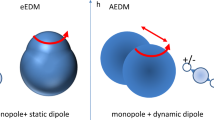The anomalous magnetic moment of the electron is calculated through introducing the effective mass of the virtual component of the electron structure. In this case, the anomalous moment is inversely proportional to the effective mass Meff which is shown to be a linear combination of the neutron, proton, and electrostatic electron field masses. The spin of the rotating structure is assumed to be equal to 3/2, while the spin of a bare electron is equal to unity and the resultant spin being 1/2. A simple analysis gives the coefficients \( \sqrt{2}/2 \) and exp(1) \( \sqrt{2}/2 \) for a linear combination of the proton and electron masses with the approximation precision giving here nine significant digits after the decimal point. The summand proportional to α2 adds four more digits. Thus, the conception of the effective mass Meff leads to the formula for the total magnetic moment of the electron accurate to the fourteen digits after the decimal point. Association with the virtual beta-decay reaction and possible reasons for the simplicity of the derived formula are discussed.
Similar content being viewed by others
References
J. D. Barrow, The Constants of Nature: The Numbers that Encode the Deepest Secrets of Universe, Random House, London (2010).
Y. Koide, Phys. Rev. D, 28, No. 1, 252 (1983); http://doi:10.1103/PhysRev D.28.252.
P. Zenczykowski, Elementary Particles and Emergent Phase Space, World Scientific, Singapore (2014).
A. Bohm and M. Loewe, Quantum Mechanics: Foundations and Applications, Springer Verlag, New York (1993).
T. Aoyama, M. Hayakawa, T. Kinoshita, and M. Nio, Phys. Rev. D, 91, No. 3, 033006 (2015); 10.1103/PhysRevD.91.033006; arXiv:1412.8284 [hep-ph].
2018 CODATA, http:// www.physics.nist.gov/cuu/constants.
S. P. Efimov, Russ. Phys. J., 56, No. 7, 740 (2013).
V. B. Berestetskii, L. P. Pitaevskii, and E. M. Lifshitz, Quantum Electrodynamics, Vol. 4, Elsevier (2012).
R. P. Feynman, The Theory of Fundamental Processes (Advanced Books Classics), CRC Press (1998).
R. J. Glauber, Phys. Rev., 131, No. 6, 2766 (1963); https://doi.org/10.1103/PhysRev.131.2766.
S. P. Efimov, Russ. Phys. J., 19, No. 3, 340 (1976).
W. Weise and A. M. Green, World Scientific (1984).
J. Schwinger, J. Math. Phys., 5, No. 11, 1606 (1964); https://doi.org/10.1063/1.1931195.
S. P. Efimov, Usp. Fiz. Nauk, 191, No. 9 (Accepted for publication) (2021); https://doi.org/10.3367/UFNr.2021.04.038966.
Author information
Authors and Affiliations
Corresponding author
Additional information
Translated from Izvestiya Vysshikh Uchebnykh Zavedenii, Fizika, No. 6, pp. 16–20, June, 2021.
Rights and permissions
About this article
Cite this article
Efimov, S.P. Relation of the Anomalous Magnetic Moment of the Electron with Proton and Neutron Masses. Russ Phys J 64, 978–983 (2021). https://doi.org/10.1007/s11182-021-02417-z
Received:
Published:
Issue Date:
DOI: https://doi.org/10.1007/s11182-021-02417-z



